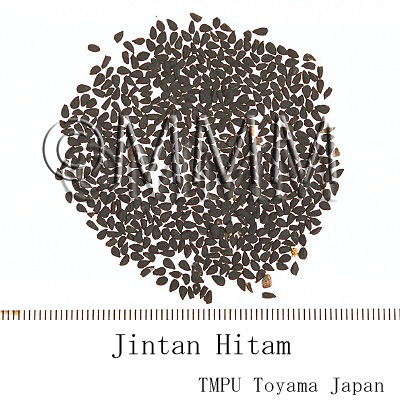Crude drug sample data base
※Click on the image to enlarge it.
Scientific information data base
| Crude drug name | Indonesian name, English name | Jintan hitam, Black cumin | |||
|---|---|---|---|---|---|
| crude drug image |
| ||||
| Original plant name | Nigella sativa Linn. | ||||
| Family name | Ranunculaceae | ||||
| Used part | Seeds | ||||
| Distribution area | Originated from Mediterranean region, the plant is cultivated from Egypt to India [201]. It is not native to Indonesia and not cultivated in Indonesia [201]. | ||||
| Description | Nigella seeds are black in colour and have sharp corners. When ground or chewed the seed develops a specific oregano-like scent. The taste is aromatic and slightly bitter. The plant is an annual flowering plant, 20-30 cm tall. Leaves are finely divided, linear. Flowers are pale blue and white with 5-10 petals. The fruit is a large capsule composed of 3-7 united follicles, each containing numerous seeds. | ||||
| Drug effect | Warming [201] | ||||
| Specific actions | Carminative, diuretic [231] | ||||
| Frequency in use | Moderate. | ||||
| Common uses | The seeds are used as a spice [201]. | ||||
| Pharmacological effect | Oral Nigella sativa treatment might decrease the diabetes-induced disturbances of thyroid hormone metabolism. Oral Nigella sativa treatment might decrease the diabetes-induced disturbances of heart rate and some haematological parameters of alloxan-induced diabetic rabbits. Reports of pharmacological and toxicological properties of Nigella sativa mentioned that much of the biological activities of the seed is due to thymoquinone as the major component of the essential oil. The pharmacological actions of the crude extracs of the seeds include protection against nephrotoxicity and hepatotoxicity induced by diseases or chemicals. The seeds or oil have anti-inflammatory, analgesic, antipyretic, antimicrobial and antineoplastic activities. The oil decreases blood pressure and increases respiration. It appears that the beneficial effects of the seeds and thymoquinone might be related to their cytoprotective and antioxidant actions [PMID: 12722128]. The hypoglycaemic effect of Nigella sativa oil may be mediated by extrapancreatic actions rather than by stimulated insulin release [PMID: 12058330]. The aqueous and methanol extracts of Nigella sativa possesses a potent CNS and analgesic activity [PMID: 12902052]. Nigella sativa seeds appeared to be safe and possibly protective against CCl4-induced hepatotoxicity [PMID: 14696675]. Aqueous extract of Nigella sativa seeds exhibits inhibitory effect against candidiasis [PMID: 12601685]. | ||||
| Medical system | Indonesian medicine (Jamu) | ||||
| Traditional usage | It is used as a diuretic, stimulant and carminative; also to cure stomachache [201, 231]. Under the Arabic name of “Habbatussauda”, the popularity of black cumin seeds is increasing especially among Moslem people in Indonesia, who regards it as one of the greatest forms of healing medicine available, believe that it can boost immune system and thus can heal a variety of health problems and prevent from diseases. | ||||
| Formulation | 1) Blurred vision: 12 pieces of Nigella seeds, 2 medium-sized of turmeric, a little amount of ginger are mixed and boiled with 110 ml of water. Stand to cool and strain. Drink 100 ml of the decoction once a day for 4 days [231]. 2) Stomachache: Take 5-7 seeds, 3 times a day for 3 days [231]. | ||||
| References | Reference book Tips! | [201] K. Heyne, Tumbuhan Berguna Indonesia, Vols. 1-4, 1987. Diedarkan Oleh Koperasi Karyawan Departemen Kehutanan, Jakarta, Indonesia. Vol. 2, p 751. [231] Soedibyo, Mooryati: Alam Sumber Kesehatan: Manfaat dan Kegunaan (Natural resources for health. Benefits and uses). Balai Pustaka. 1998. pp 176-177. | |||
| Research paper | 1. Al-Ghamdi MS. Protective effect of Nigella sativa seeds against carbon tetrachloride-induced liver damage. Am J Chin Med. 31(5):721-8, 2003. (PMID: 14696675) 2. Al-Naggar TB, Gomez-Serranillos MP, Carretero ME, Villar AM. Neuropharmacological activity of Nigella sativa L. extracts. J Ethnopharmacol. 88(1):63-8, 2003. (PMID: 12902052) 3. Ali BH, Blunden G. Pharmacological and toxicological properties of Nigella sativa. Phytother Res. 17(4):299-305, 2003. (PMID: 12722128) 4. Khan MA, Ashfaq MK, Zuberi HS, Mahmood MS, Gilani AH. The in vivo antifungal activity of the aqueous extract from Nigella sativa seeds. Phytother Res. 17(2):183-6, 2003. (PMID: 12601685) 5. El-Dakhakhny M, Mady N, Lembert N, Ammon HP. The hypoglycemic effect of Nigella sativa oil is mediated by extrapancreatic actions. Planta Med. 68(5):465-6, 2002. (PMID: 12058330) | ||||
| Last renewal date | 2024/03/05 | ||||




